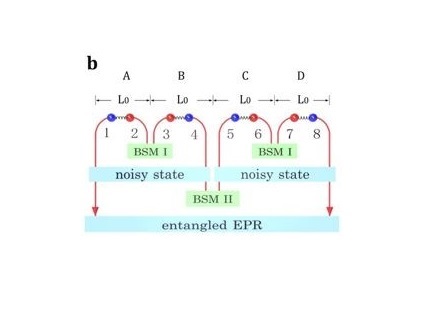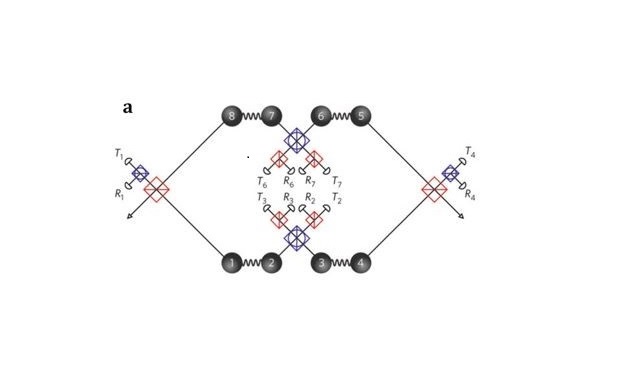2017-11-11
Recently, utilizing spontaneous parametric downconversion(SPDC) sources, experimental nested purification for a linear optical quantum repeater and process of two-hierarchy entanglement swapping firstly implemented by PAN Jianwei, professor of Univeristy of Science and Technology of China (USTC), and his colleagues CHEN Yuxiang and ZHAO Bo, etc. worldwide. Based on this technology, the main noise that obstructed the further coherent operation during the quantum entanglement exchanging process can be automatically removed, which provides a forward-looking technical guideline for the future realization of anextensible linear optical quantum repeater based on atomic ensembles. These two important achievements were published in "Nature Photonics" and "Physical Review Letters" respectively.
Quantum repeaters are essential components for ground-based remote quantum communication. Affected by factors such as attenuation of the communication link and noise, there is a limit to the node distance for direct quantum communication. To break this limit, using quantum repeaters to connect multiple communication nodes in order to achieve long-range quantum communication is a practical method. Therefore, since the concept of quantum repeater was proposed in 1998, scientists have been working hard to build a practical quantum repeater. In order to extend the communication distance, continuous entanglement manipulation is the basic requirement to fully implement quantum repeaters. This can be achieved by entanglement exchange and nested purification. The entanglement exchange is used to lengthen thetransmission distanceof the quantum state and the nested purification is used to resist the decoherence effect in quantum state transmission.
The initial quantum entanglement exchange and nested purification have been successfully demonstrated in linear optics systems, but previous work has not been able to provide extensibility, that is, the obtained distribution state cannot be directly used for subsequent entanglement manipulation. This is due to the parametric transformation of entangled sources to generate photon pairs is probabilistic. Due to the existence of two-photon noise in the down-conversion process, the quantum distribution states are essentiallymixed with50% entangled statesand 50% unwanted states. In the past, scientists could only use post-selection to extract the entangled state from the mixed state.However, the post-selectionis destructive, which may lead to the collapse of distributed quantum state to be measured, and hence the distributed state could no longer be used for the next entanglement manipulation. Therefore, scientists must seek a non-destructive method to eliminate this noise, and nested entanglement purification and cascade entanglement exchange are capable to solve this problem.

Figure 2. the mechanism of two-hierarchy quantum entanglement swapping (Image by PAN Jianwei)
Pan Jianwei’s team has long been committed to the practical research of quantum repeaters, leading especially in the multi-photon entanglement preparation and manipulation worldwide. The eight-photon and ten-photon control technology mastered by the multi-photon group provides hardware support for the principle demonstration of realizing the photonic repeater in the parametric downconversion system. In 2008, the team built a quantum repeater node that mingled with entanglement exchange and quantum storage also lay a solid foundation for the future realization of quantum repeaters based on atomic ensemble system. In 2016, the team successfully developed a hundred-millisecond-level high-efficiency quantum memory based on cryo-atomic ensemble to achieve a high-performance quantum memory with a storage life of 0.22 seconds and a read efficiency of 76%. For the first time, the storage life and read efficiency are upgraded to meet the actual needs of long-distance quantum repeat. This time, based on the eight-body entangled light source, the nested quantum entanglement purification and cascade quantum entanglement exchange are firstlydemonstrated. By cleverly setting Bell state measurement(BSM) facility, it not only completely eliminates the two-photon interference in the entanglement exchange process, but also retains the distributional quantum states for further maneuverability. The optical demonstration of the extensible quantum repeater was successfully implemented by using a combination of fiber analog quantum storage and measurement feedback facility. This pioneering work has further verified the feasibility of constructing a quantum repeater based on parametric down-converted light sources. In particular, the atom-photon entangled source in the atomic ensemble system has the same two-photon noise as the parametric downconversion source, so this technique can also be directly applied to quantum repeaters based on atomic ensembles.
Both of these two efforts have come over the long-term technological obstacles that quantum repeaters can only demonstrate single entanglement manipulation in the past. For the first time, continuous entanglement control of quantum states is successfully achieved. The extensible quantum repeater technologybased on the linear optical system smashed the solid barrier in the development of practical photonic repeaters. This result shows that the parametric downconversion source is fully capable of becoming another trusted system for a practical photonic repeaterin principle. At the same time, these two efforts will also vigorously promote research in extensible quantum repeater technology based on atomic quantum repeater technology. The reviewer gave a high evaluation of both results, among which the nested purification experiment was praised by reviewers as "hero experiment" and the cascade entanglement exchange experiment was considered by reviewers as "very good experimental work, dealing with such an important issue in the field of quantum information. "
The link of the paper:
http://www.nature.com/articles/s41566-017-0010-6
https://journals.aps.org/prl/abstract/10.1103/PhysRevLett.119.170502













